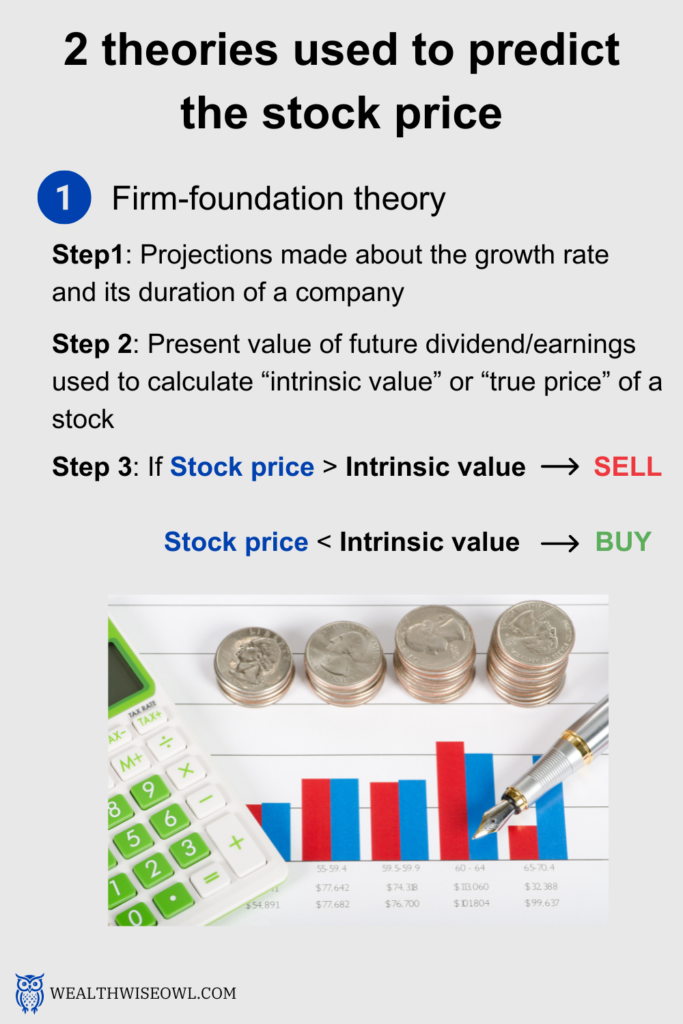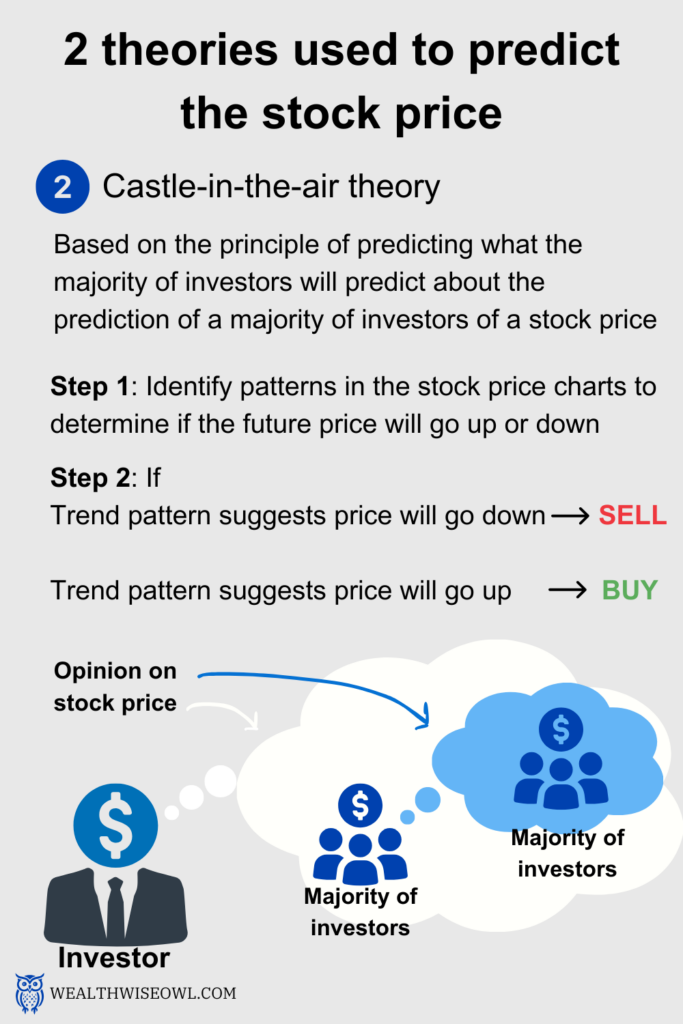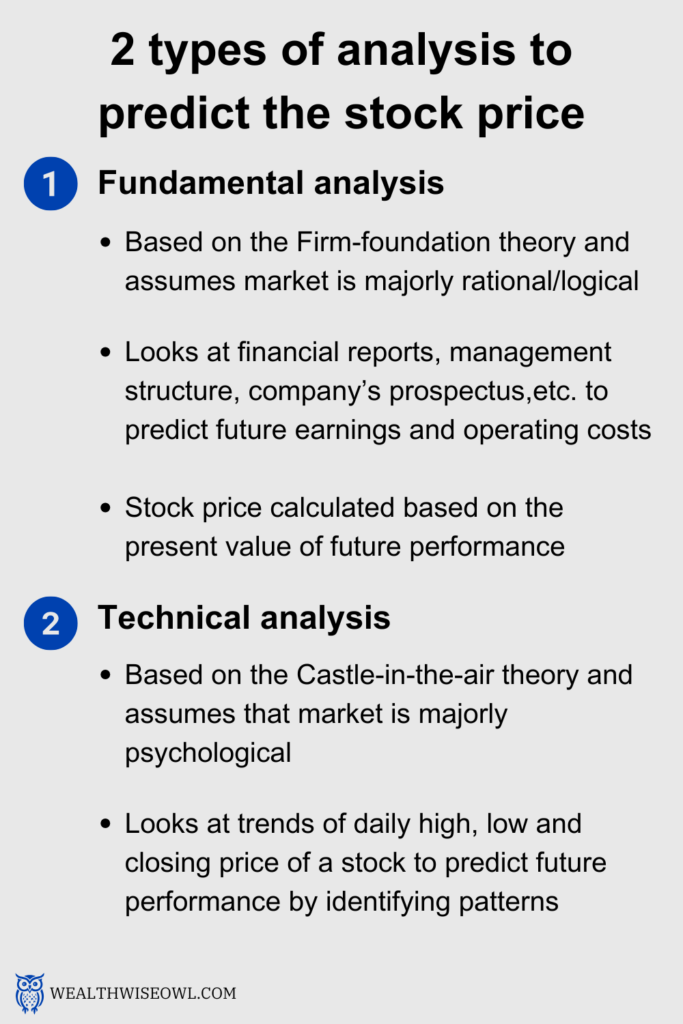Whenever we talk about investing in the stock market, the famous adage is to “buy low and sell high”. But I have always wondered how you determine what is low and what is high? How do you know the true value of a stock? If we can find out what the true value of a stock is, shouldn’t everybody be able to make a profit in the stock market? All these questions were front and center in my mind. I also heard in a Warren Buffett interview that it is safer to stay away from individual stocks and focus on index funds, because it is really hard for mere mortals like us to know the true value of stocks. So, why is it so hard to predict the true value of a stock? I must admit that I do not have all the answers but atleast I have begun to scratch the surface. I would like to share some really good information about the two main theories behind stock price evaluation. Major credit goes to the book “Random Walk Down Wall Street”, where I came across a lot of the content. the This would be a good start to understand some of the basics and I will try to dig more into it later. Let us listen in on the conversation with the Wealth Wise Owl.
Use the links below to jump to specific sections
Conversations with Wealth Wise Owl

Happy New year my friend! Hope you had a great end of the year celebration.

Happy new year! Yes, I enjoyed the fireworks from my place and it was really beautiful. How has your start of the year been?

It has been a good start to the year! The end of the year was full of travel and festivities and now cannot wait to start the year on a good note. I have my resolutions all listed down and hope to keep it for at least for two weeks!

That is excellent! I hear your pain about keeping up with new year resolutions. I would suggest to take one day at a time and not look too far ahead if you are aiming for some results. What is one of your top three new year resolutions?

It will not come as a surprise to you but I really want to understand the stock market better. We have had all these conversations about investments last year and I want to understand the stock market where we make all these investments. The first thing I want to understand is how do you value a stock?

This is a great undertaking and I am glad you have started this early in the year. We have not explicitly discussed this but you need to understand what a stock is. A stock in layman terms represents a small ownership of the company. A company issues stocks to raise money from the public or markets. These stocks are sold in the stock market at a certain price that is governed by supply and demand. The investors who buy the stock own a small equity or ownership of the company. They benefit when the company does well as it is reflected in either increase in the value of the stock and/or increase in dividends paid by the company. They also tend to lose out if the company underperforms. For investors, it is therefore profitable to buy stocks of companies that are bound to do well and perform beyond expectations, so that they can profit from their investments. Since nobody has a crystal ball to foresee how a company would perform in the future, investors rely on past data and future estimates to make predictions. This is where different theories come in as to how to use data to make predictions on the future performance of a company and hence it’s stock price.

I am glad you gave a refresher on what a stock of a company stands for. It seems so simple in theory on how to profit in the stock market but the biggest challenge is to identify where the opportunity lies. I would be interested to know what kind of theories are out there to find the true value of a stock.

There are two main theories that are useful for evaluation of stocks or any assets for that matter: Firm-foundation theory and Castle-in-the-air theory. We can talk about them one at a time.
Firm-foundation theory: This theory believes that every asset has an underlying or “intrinsic” value, which can be calculated based on present conditions and future prospects. When market prices fall below this “intrinsic value”, it is a buying opportunity and if they are above this intrinsic value then it is a selling opportunity. The intrinsic value of common stocks can be calculated based on the present value of future dividends. The higher the dividends payout in the upcoming years, the higher the value of stock will be.In this theory, there are four main determinants that can qualitatively evaluate or compare a stock prices:
- Expected growth rate of dividends: Dividends are money paid to the company’s shareholders of the company and comes out of the company’s profits. So, if a company is expected to make huge profits in the coming years, the shareholders can expect to get more in terms of dividends. Therefore, the growth rate of a company and its dividends are expected to go hand in hand. This first determinant states that the stock price of a company will be higher if its expected to have a high growth rate of dividends and that too over a longer period of time.
- Expected dividend payout: A company makes the decision on how much of its profits or earnings it wants to hand out to the shareholders as dividends. Usually, if the company is relatively small and looking to grow, it will want to reinvest all the profits into growing further. This means it will payout little to no dividends. However, a company that has already grown big and expects a very modest growth rate, can afford to hand out more of its profits as dividends since there are no other attractive opportunities to use their profits. This determinant states that if two companies are very similar in terms of their growth potential, then the one that has a higher dividend payout will have a higher stock price.
- The degree of risk: Investors tend to value less-risky assets or to be more precise “rational” investors tend to seek out assets that have low risk associated with them. Risk is oftentimes subjective but there are also methodologies to quantify risk. Once an investor has assessed the risk using whatever methodology they prefer, a “rational” investor would pay higher for an asset that is less risky given that all other things are equal. By all things equal, it is meant that we will compare assets that are very similar in nature i.e. not compare the risk in a technology company against a pharmaceutical company.
- The level of market interest rates: The Federal Funds rate plays an important role in setting the short term borrowing rate and also the rate of return on bonds. Investors always look at these rate of return on bonds, which are less riskier than stocks, to set their expectations from stocks and their desire to invest in them. If the Federal Funds rate is high, then it means that the investors can get a high rate of return or yield% from investing in bonds. Hence, they will prefer to invest more in bonds to get a relatively risk-free return. This will reduce the demand for stocks and, as a result, stock prices would drop. The stock prices will drop till it makes sense for investors to take that higher risk and the potential for upside is also high. This determinant states that the investor will pay a higher price for a stock, other things being equal, if the interest rates are low.
These determinants that we discussed give us enough information to make general comments on the value of a stock but not tell exactly how much lower or higher the stock price is from the intrinsic value. The exact calculation requires us to make assumptions on the rate of growth of dividends and also the duration of growth. Both these assumptions are very subjective since no one can predict the future. For example, a company might be doing well in the present and this might make investors predict a high rate of growth in the future but they cannot anticipate things like pandemic, technological revolution, government policy changes, etc. that can all impact the growth rates. So, one could argue that doing exact calculations based on assumptions will not give you an accurate price of a stock.


That is some really good information! I understand why it is called the Firm-foundation theory because it assumes there is some foundation value to an asset and that is what the market will eventually price it at. How is this theory applied to make judgement of the stock price?

The analysis that uses this theory is called Fundamental analysis. This analysis estimates the future earnings and dividends of a company by projecting its sales, operating costs, corporate tax rates, etc. in the future.This future stream of earnings/dividends is then used to calculate the present value of the stock, which is the intrinsic value we talked about before. People who do this analysis are called Security Analysts.To make the prediction of a company’s future performance, they would have to study the industry as a whole and make predictions on the future prospects of that industry. Then they would have to evaluate if the company has any advantages over its competitors to benefit from the future prospects of the industry and how that would translate into its sales, operating costs, etc. There are several dense books and even courses offered to learn the calculation of present value of a stock based on all information on a company’s future performance. Some of the information that a security analyst would gather is the Quarterly earnings report, Financial reports, Letter from the CEO to shareholders, Management structure, Company prospectus, etc. It is a time consuming effort and needs really good interpretation skills to make sense of huge amount of data that is both qualitative and quantitative.
https://www.investopedia.com/terms/f/fundamentalanalysis.asp

I see. I will put the action to look for the courses that teach this Fundamental analysis on my To do list. It will be interesting to learn how this massive amount of information boils down to a stock price, which can tell me if a stock is undervalued or overvalued. You said there is another theory that is for evaluating stock prices, right?

Yes, the other theory is called the Castle-in-the-air theory and it is completely opposite in principle from the Firm-Foundation theory. You can say that they are at the opposite end of the spectrum in theories for stock valuation.
Castle-in-the-air theory: This theory does not believe that there is an intrinsic value of a stock but instead it is what a bunch of investors are willing to pay that will determine its price. It is the belief of the investors about what others will pay for that stock that will decide how much they are willing to pay for it. For example, if an investor thinks that someone will be willing to pay $150 for the stock then he/she will happily pay $100 for the stock. The investor who will pay $150 for the stock in the future has to believe that someone else will be willing to pay $200 for the same stock. Hence, regardless of what the true or intrinsic value of the stock is, the amount the majority of investors are willing to pay for a stock, which is again based on what they think the majority of investors will pay for the stock, will determine the price of a stock. It is therefore all about predicting what majority of investors will predict that a majority of investors will be willing to pay for the stock. If you can guess this and get in the game early by predicting before anyone else, then you will be able to make a lot of profit. This theory is based more on mass psychology and less on mathematics or calculations we discussed in the Firm-Foundation theory.


I love the idea of using mass psychology to predict a stock price. Based on the news I see about massive increases in prices of some stocks when there is a lot of excitement around, I can see how investor sentiment can have a strong influence on a stock price. I would assume someone good at this would be able to read people very well and anticipate their decisions when it comes to buying or selling stocks. Is that right?

You are right! One of the requirements to apply this theory is to understand human psychology, specifically investor psychology, and how it translates to trading in the stock market. The analysis that is largely based on this theory is called Technical analysis. The assumption in this analysis is that the behavior of the stock market is majority psychological and less logical. The people who apply this analysis for trading in the stock market are called chartists or technicians. They study the movements of common stock prices and volume of trading for predicting the behavior of stock price in the future. There are two major principles that this analysis is based on:
- A company’s information about earnings, dividends and future performance is all reflected in the past stock price. A chart that shows the past stock price and volume of trading contains all the fundamental information that someone needs to know to buy or sell a stock.
- Stock prices tend to move in trends. Usually, a stock that is rising will keep on rising, whereas something that is flat will remain flat.
A chart basically tracks the daily low, high and closing price of a stock. Patterns emerge from this daily tracking of stock prices which are then used to predict the future price. There are several books and resources that talk about different patterns and how to interpret them to decide whether to buy or sell a stock. The reason why analyzing patterns is grounded in the Castles-in-the-air theory or mass psychology is because:
- When investors see the price of a stock is going up then they do not want to miss the boat and jump in the action, pushing the price of a stock even higher. As more investors jump in, the trading volume picks up and it is also captured in the stock market news. This causes more investors to jump in because of the fear of missing out. Hence, a stock price that is rising tends to keep rising, which is what the second principle of this analysis is.
- People remember what they paid for a stock or what they wish they had paid for a stock. For example, let’s say a group of investors paid $100 for a stock, which was at that price for a while. If the price of the stock then drops to $90, then the group of investors will be anxious to sell the stock whenever it reaches back to the price they had paid for $100 so that they break even. This is human psychology that tends to avoid losses than to risk for more gains. The price of the stock will decrease below $100 as the investors sell and everytime the price of the stock hits $100, this trend will repeat till majority of the investor group have sold their shares. This creates a resistance level at the $100 price.
Similarly a support level is created by investors who did not buy the stock when it had reached $90 and saw it reach $100. They will tend to buy the stock whenever it drops to $90 the next time. Hence, if enough investors keep buying the stock when it reaches the $90 price, it will create a support level of $90.
You might have heard the terms like stock has broken the resistance levels and is now on a bullish trend or it has gone beyond the support levels and is on a bearish trend. This is the lingo that chartists and day traders use while analyzing stock prices.


I have heard these terms being used a lot whenever I am watching analysts talk about day trading. I am glad I have finally understood why some of these terms are used and how they are related to investors’ psychology around either avoiding losses or fear of missing out on profits. Do you think theory is better than the Firm-Foundation theory?

It is hard to compare both these theories because they serve different purposes. The Firm-Foundation theory is mainly used for long term investments over a period of years whereas the Castle-in-the-air theory is used for something like day trading or making decisions on investments over a few weeks. So, it depends on what type of investor you are that you might find one theory better than the other. There are also other theories that lie somewhere in between these two theories and you are free to even make your own theory by mixing and matching concepts you like in both these theories!

Thank you so much for sharing this because at least I know the two major schools of thoughts around stock price valuation. I am sure we will talk more about this during the rest of the year!


